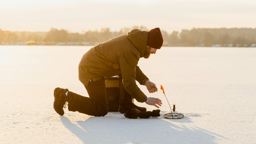Outdoor winter activities at the cabin not only give you the chance to see nature’s beauty in a whole new way, they also often give you the chance to get thoroughly chilled. But staying warm and dry when the mercury drops is a lot easier thanks to today’s technical gear and accessories for winter adventures like hiking and snowshoeing.
CLOTHES WITH GILLS
One of the greatest innovations in modern outdoor apparel was the invention of waterproof breathable fabrics. Unlike a heavy vinyl or PVC raincoat that keeps rain out but sweat in, waterproof breathable fabrics have pores that are too small to let raindrops penetrate, but large enough to let body-generated moisture out. The pores inside some waterproof breathable fabrics are 20,000 times smaller than a drop of water, which means that no external moisture – from rain to snow to that puddle you just stepped in – can penetrate the membrane.
A waterproof breathable membrane is typically hidden between two layers of fabric, one that forms the outside of the coat, pant, boot or glove, and one that forms the inside.
Waterproof breathable fabrics are the best option when you’re active in the outdoors, though they’re not perfect. If you’re working hard – climbing a big mountain or cutting trees around your camp – you may sweat more than the membrane can handle. The solution: buy waterproof breathable clothes with extra venting, like waterproof jackets with zippers in the armpits or boots with a wicking sock liner, that will help transfer moisture out. Or, look for one of the new fabrics with “intelligent” microporous membranes. The
membrane’s pores open and close when they detect changing moisture levels inside and outside to most effectively transfer moisture from inside to outside without letting the elements in.
CLOTHES WITH GILLS
One of the greatest innovations in modern outdoor apparel was the invention of waterproof breathable fabrics. Unlike a heavy vinyl or PVC raincoat that keeps rain out but sweat in, waterproof breathable fabrics have pores that are too small to let raindrops penetrate, but large enough to let body-generated moisture out. The pores inside some waterproof breathable fabrics are 20,000 times smaller than a drop of water, which means that no external moisture – from rain to snow to that puddle you just stepped in – can penetrate the membrane.
A waterproof breathable membrane is typically hidden between two layers of fabric, one that forms the outside of the coat, pant, boot or glove, and one that forms the inside.
Waterproof breathable fabrics are the best option when you’re active in the outdoors, though they’re not perfect. If you’re working hard – climbing a big mountain or cutting trees around your camp – you may sweat more than the membrane can handle. The solution: buy waterproof breathable clothes with extra venting, like waterproof jackets with zippers in the armpits or boots with a wicking sock liner, that will help transfer moisture out. Or, look for one of the new fabrics with “intelligent” microporous membranes. The
membrane’s pores open and close when they detect changing moisture levels inside and outside to most effectively transfer moisture from inside to outside without letting the elements in.
TOASTY DIGITS
The two most popular hand warmers on the market are chemical warmers, both disposable and reusable, and electric warmers. They come in a wide variety of shapes and sizes, and they stay warm for anywhere from 30 minutes to 48 hours. Some are designed to slip inside a glove, others to tuck under your toes, while others replace your shoe’s foot bed.
Disposable Chemical Warmers.
These are ideal for keeping toes and fingers toasty on cold days, or for acting like a heat pack lending extra warmth to a strained back. They are also a great way to keep your video or camera battery at maximum power (tuck one in your pocket with your battery), or, if you’re using a hydration pack, to keep your bite valve from freezing up (stick the warmer inside the bite valve garage).
Disposable hand warmers are typically air activated. Break the vacuum seal on the plastic pouch it comes in, pull it out and it will start generating heat immediately. The cloth-like pouch inside the plastic wrapper is typically filled with iron, water, carbon and salt. When it is exposed to oxygen, an exothermic (heat producing) reaction takes place as the oxygen bonds with the iron in a process that is like high speed rusting. Some single-use warmers last an hour or two, but some last 12, 24 and even 48 hours depending on how much material the pouch contains, and how fast it lets O2 in.
Reusable Chemical Warmers.
But to have warm hands, you don’t need a throw-away pouch. Reusable hand warmers typically contain a non-toxic salt-based solution and an activator – in some cases a metal disk – all sealed inside a PVC pouch. Click the disk back and forth a couple of times, and it causes a reaction between the salt and the metal that crystallizes the solution, releasing heat in the process. When the warmer is used up, wrap it in cloth (an old sock or a bandana will do just fine) and boil it – which will turn the solution inside the pouch liquid again – and it will be ready for its next use.
With reusable warmers, you’re not adding trash to landfills each time you warm your fingers (this type of warmer can be reused about 100 times before the pouch fails). But reusable hand warmers are not perfect either. They are larger and heavier than disposable hand warmers. They stay hot for 30 minutes to up to a few hours – not as long as some of the disposable warmers.
Electrical Warmers.
Heated ski boots have been around for decades. And in the past few years, heated winter clothing, gloves and footwear – that use batteries to heat a filament running through the garment to warm you – have become more and more common and affordable.
Some of these garments are like mini electric blankets that wrap your hands, feet or body. Others use strategically placed heating patches to spot-warm you. The best heated winter wear uses long lasting lithium ion batteries that will put out warmth for six to eight hours, and they are typically chargeable through the wall or through your computer USB port. Most can be adjusted through controls on the shoe, jacket or glove they are heating. Battery-powered winter wear provides the most reliable warmth, but try before you buy to make sure that the wires and electronics are comfortable where they are placed and won’t interfere with your activity.
The two most popular hand warmers on the market are chemical warmers, both disposable and reusable, and electric warmers. They come in a wide variety of shapes and sizes, and they stay warm for anywhere from 30 minutes to 48 hours. Some are designed to slip inside a glove, others to tuck under your toes, while others replace your shoe’s foot bed.
Disposable Chemical Warmers.
These are ideal for keeping toes and fingers toasty on cold days, or for acting like a heat pack lending extra warmth to a strained back. They are also a great way to keep your video or camera battery at maximum power (tuck one in your pocket with your battery), or, if you’re using a hydration pack, to keep your bite valve from freezing up (stick the warmer inside the bite valve garage).
Disposable hand warmers are typically air activated. Break the vacuum seal on the plastic pouch it comes in, pull it out and it will start generating heat immediately. The cloth-like pouch inside the plastic wrapper is typically filled with iron, water, carbon and salt. When it is exposed to oxygen, an exothermic (heat producing) reaction takes place as the oxygen bonds with the iron in a process that is like high speed rusting. Some single-use warmers last an hour or two, but some last 12, 24 and even 48 hours depending on how much material the pouch contains, and how fast it lets O2 in.
Reusable Chemical Warmers.
But to have warm hands, you don’t need a throw-away pouch. Reusable hand warmers typically contain a non-toxic salt-based solution and an activator – in some cases a metal disk – all sealed inside a PVC pouch. Click the disk back and forth a couple of times, and it causes a reaction between the salt and the metal that crystallizes the solution, releasing heat in the process. When the warmer is used up, wrap it in cloth (an old sock or a bandana will do just fine) and boil it – which will turn the solution inside the pouch liquid again – and it will be ready for its next use.
With reusable warmers, you’re not adding trash to landfills each time you warm your fingers (this type of warmer can be reused about 100 times before the pouch fails). But reusable hand warmers are not perfect either. They are larger and heavier than disposable hand warmers. They stay hot for 30 minutes to up to a few hours – not as long as some of the disposable warmers.
Electrical Warmers.
Heated ski boots have been around for decades. And in the past few years, heated winter clothing, gloves and footwear – that use batteries to heat a filament running through the garment to warm you – have become more and more common and affordable.
Some of these garments are like mini electric blankets that wrap your hands, feet or body. Others use strategically placed heating patches to spot-warm you. The best heated winter wear uses long lasting lithium ion batteries that will put out warmth for six to eight hours, and they are typically chargeable through the wall or through your computer USB port. Most can be adjusted through controls on the shoe, jacket or glove they are heating. Battery-powered winter wear provides the most reliable warmth, but try before you buy to make sure that the wires and electronics are comfortable where they are placed and won’t interfere with your activity.
CATCH SOME RAYS
Heat reflective clothing is another way to battle winter cold. Recently, winter outerwear with a heat reflective liner that bounces body heat back to you has gained in popularity. The best reflective liners are breathable and keep you about 20 percent warmer than the same unlined garment or shoe. Typically, reflective layers are used in apparel and footwear. But beware – sometimes these liners are not breathable and leave you feeling like you’re wearing a sweat-retaining plastic bag!
Using any or all of the technologies above will result in a drier, warmer and (most important of all) happier cold-weather adventure!
Berne Broudy is a freelance writer and photographer based in Vermont, where there are nine months of winter and three months of darn poor sledding.
Heat reflective clothing is another way to battle winter cold. Recently, winter outerwear with a heat reflective liner that bounces body heat back to you has gained in popularity. The best reflective liners are breathable and keep you about 20 percent warmer than the same unlined garment or shoe. Typically, reflective layers are used in apparel and footwear. But beware – sometimes these liners are not breathable and leave you feeling like you’re wearing a sweat-retaining plastic bag!
Using any or all of the technologies above will result in a drier, warmer and (most important of all) happier cold-weather adventure!
Berne Broudy is a freelance writer and photographer based in Vermont, where there are nine months of winter and three months of darn poor sledding.











